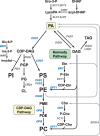Regulation of phospholipid synthesis in yeast
- PMID: 18955729
- PMCID: PMC2674725
- DOI: 10.1194/jlr.R800043-JLR200
Regulation of phospholipid synthesis in yeast
Abstract
Phospholipid synthesis in the yeast Saccharomyces cerevisiae is a complex process that involves regulation by both genetic and biochemical mechanisms. The activity levels of phospholipid synthesis enzymes are controlled by gene expression (e.g., transcription) and by factors (lipids, water-soluble phospholipid precursors and products, and covalent modification of phosphorylation) that modulate catalysis. Phosphatidic acid, whose levels are controlled by the biochemical regulation of key phospholipid synthesis enzymes, plays a central role in the regulation of phospholipid synthesis gene expression.
Figures


References
-
- Carman G. M., and S. A. Henry. 1999. Phospholipid biosynthesis in the yeast Saccharomyces cerevisiae and interrelationship with other metabolic processes. Prog. Lipid Res. 38 361–399. - PubMed
-
- Gaspar M. L., M. A. Aregullin, S. A. Jesch, L. R. Nunez, M. Villa-Garcia, and S. A. Henry. 2007. The emergence of yeast lipidomics. Biochim. Biophys. Acta. 1771 241–254. - PubMed
-
- Carman G. M., and G. M. Zeimetz. 1996. Regulation of phospholipid biosynthesis in the yeast Saccharomyces cerevisiae. J. Biol. Chem. 271 13293–13296. - PubMed
Publication types
MeSH terms
Substances
Grants and funding
LinkOut - more resources
Full Text Sources

